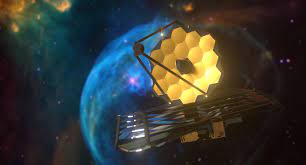- The James Webb Space Telescope has revealed precise views into somewhat older galaxies, called as ‘teenagers’ in cosmic parlance, shed light on their history and distinctive traits.
- This study is part of the CECILIA Survey, which is named for astronomer Cecilia Payne-Gaposchkin and uses Webb to analyse the chemical of distant galaxies.
Teenage Galaxies Formation Period:
- The research focuses on galaxies that originated roughly 2-3 billion years after the Big Bang, which happened approximately 13.8 billion years ago.
- Researchers used Webb to analyse light at various wavelengths from 23 such galaxies, similar to researching their ‘chemical DNA.’
- Key Findings: These adolescent galaxies have different chemical compositions, indicating strong star creation and quick growth stages.
Characteristics of Teenage Galaxies in Comparison to Modern Galaxies:
- These galaxies differ significantly in appearance and behaviour from modern galaxies.
- Developmental Mysteries: During this phase, they go through critical, but not entirely understood, processes that shape their eventual form and character.
- High Temperatures in Star-Forming Regions: Temperatures in star-forming regions in these galaxies are approximately 24,000 degrees Fahrenheit, which is substantially higher than in present-day galaxies.
- Young Stars and Gas characteristics: The temperature fluctuation shows that the stars and gas characteristics of adolescent galaxies differ.
- Elements Observed: These galaxies were found to be blazing with elements like as hydrogen, helium, oxygen, nitrogen, sulphur, argon, nickel, and silicon.
The Importance of Oxygen and Nickel
- The Importance of Oxygen: As the third-most prevalent element in the cosmos and a fundamental component of galactic DNA, oxygen is critical for tracing the evolution of galaxies.
- Nickel – An Unexpected Discover: The presence of nickel, which is generally not strong enough to be seen in adjacent galaxies, shows that big stars in these galaxies have special properties.
- Undiscovered Elements: Astronomers assume that more elements exist in these galaxies but have yet to be discovered owing to technical limitations.
The Findings’ Implications
- Chemical Immaturity and Rapid Growth: According to the study, these galaxies are in a rapid creation phase and are still chemically immature.
- Understanding the chemical nature of these galaxies offers significant information about the history and rate of star creation.
Source: https://www.thehindu.com/sci-tech/science/james-webb-space-telescope-spies-precocious-teenage-galaxies/article67565120.ece

